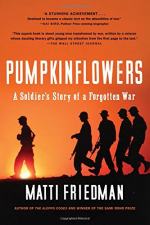|
This section contains 636 words (approx. 2 pages at 400 words per page) |

|
Pumpkinflowers: A Soldier's Story of a Forgotten War Summary & Study Guide Description
Pumpkinflowers: A Soldier's Story of a Forgotten War Summary & Study Guide includes comprehensive information and analysis to help you understand the book. This study guide contains the following sections:
This detailed literature summary also contains Topics for Discussion on Pumpkinflowers: A Soldier's Story of a Forgotten War by Matti Friedman.
The following version of the book was used to create this study guide: Friedman, Matti. Pumpkinflowers: An Israeli Soldier’s Story. Signal, 2016. Amazon Kindle E-book.
Pumpkinflowers is about the war in the Israeli security zone in Southern Lebanon during the 1990s and its immediate aftermath. The story is told from several perspectives and is therefore divided into four parts. What unites the varying parts and perspectives is one particular military outpost where various characters were stationed at different times. This outpost is called The Pumpkin.
Part One tells the story of a young Israeli soldier named Avi who served on the Pumpkin in the mid-1990s. Avi is sensitive and self-aware. He is cynical about the military but still feels bound by responsibility. He dreams of the adult life he will begin when his service is over and writes beautifully about his life in the military, including the feeling that he is losing his innocence. Avi likes to read and is drawn to the works of writers who have served in past conflicts such as the World Wars. Avi's time on the Pumpkin is punctuated with bursts of violence, guerrilla attacks, and ambushes. The author also deviates slightly from Avi's narrative in this section in order to contextualize the political history of Israel and Lebanon, and to tell some stories of other soldiers who served on the Pumpkin during the same period in the mid-1990s. At the end of this section, Avi and his entire platoon are killed in a helicopter crash.
Part Two focuses on the response to the helicopter crash which killed seventy-three young men. It tells the story of two women, Bruria and Orna, who begin to organize a movement in favor of pulling out of the Lebanese security zone entirely. At first, they are seen as disloyal and traitorous, but slowly the tide of public opinion begins to shift in their favor. At the same time, just three weeks after the helicopter crash, author Matti Friedman gets his own draft notice.
Part Three is about the author's own experiences serving on the Pumpkin in the late 1990s. His time there is characterized by long periods of inactivity punctuated by bursts of warfare and extreme violence. Like Avi, Friedman also connects his present experiences to those of past soldiers fighting in the World Wars. He also connects his experiences to the future by writing about how the type of guerrilla warfare fought in the security zone would soon spread to the rest of the Middle East. By 1999, the general Israeli population is in favor of withdrawing from the security zone and a change in government makes this plan a reality. Friedman then writes about the final days of the security zone, the army's withdraw, and the destruction of the Pumpkin along with the rest of the military's outposts in Lebanon.
Part Four is about the immediate aftermath of the withdraw from the security zone. Friedman touches on some of his civilian life but focuses more on the new political context and military conflicts which emerged in Israel and the Middle East as a whole in the early years of the 21st century. However, the majority of this section focuses on Friedman's journey back to Lebanon as a civilian tourist, a trip he is able to take because he also has Canadian citizenship. In Lebanon, Friedman makes friends with the locals but also experiences anti-semitism first-hand. He travels south where few tourists go into the former security zone, seeing it this time from the perspective of his former enemies, and returns to what remains of the Pumpkin. Though he had thought this experience would be a kind of conclusion, he now knows that it was the beginning of "a new era in which conflict surges, shifts, or fades but doesn't end" (222).
Read more from the Study Guide
|
This section contains 636 words (approx. 2 pages at 400 words per page) |

|



